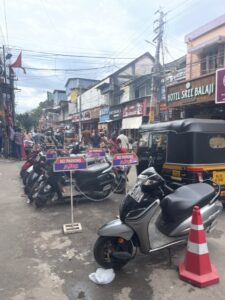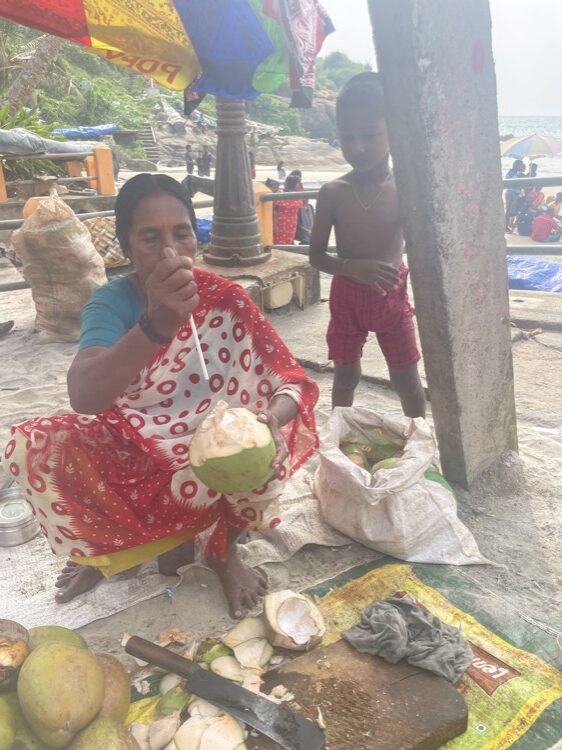During my first visit to India years ago, I visited Mumbai, Bangalore and spent a month in Mysore, where a girlfriend and I practiced our beloved Mysore-style Ashtanga yoga. Upon returning home, I filed for divorce and my mother’s turbulent cancer journey commenced. Let’s just say India is synonymous with titanic shifts for me. During this trip, I journeyed to Kovalam, which is in the state of Kerala in southwestern India, to practice Mysore-style Ashtanga yoga under the tutelage of the internationally recognized Seattle-based yoga teacher David Garrigues, at the instigation of my brother, who has studied with Garrigues and would also be joining me.
When I caught my flights last December—first to Doha, then Thiruvananthapuram—it was clear that I needed to shift. My life at home had become too much with work and being on the go. I knew that I needed to break the endless cycle of action, but it was hard, as I thrived on it. The thing about a go-go-go mindset is that it’s addicting. You get so wrapped up in the motion, so enamored with its efficiency and flow, that stopping doesn’t seem to be an option. However, in quieting down all the noise and busy-ness, we begin to connect with ourselves and the chance for reflection, clarity and growth exists. As 2022 came to an end, I knew that stepping into the unknown would help me to reconnect and reflect, and while I craved it, I also feared it. Unraveling often hits hard.
Initiation
There is a magic to India that infiltrates one’s being slowly, first through the senses with its smells of burnt eucalyptus, sweet jasmine and nag champa incense; the sounds of horn-blaring rickshaws and cars reeling through hectic streets thronged with people of all ages; hazy sunshine and thick humidity which dampens the air and penetrates the skin. India encapsulates one’s mind and spirit through its slower, more focused and intentional pulse, in which rush and hustle doesn’t exist. When ordering a coffee or a taxi, my brother often reminded me, “It will take some time.” Then there are the locals, with their timid smiles and persuasive antics to serve, sell and please. It’s hard to take for granted lush America amid the frenzied and littered streets, most without traffic lights or stop signs. And yet, there is a richness to the people and landscape, to the flavors and ritual, to the juxtaposition of simplicity and complexities that abound. India has a vibrancy of its own.
In Kovalam, the waves of the Arabian Sea cascading the shore were the soundtrack for all that unfolded along the mile strip of Lighthouse Beach, from sunrise to sunset. While my prior trip to India filled me with time and space—two gifts that prepared me for so much to come over the years—this time around, India was about finding my way, literally through the maze of alleys packed with restaurants, makeshift shops and tourist-filled hotels.
Yoga Journey
Yoga has been a critical part of my path for the last three decades. I began practicing Ashtanga yoga in New York City in 1995, two years after I began to run long distances. I was introduced to Ashtanga at New York Road Runners Club, under the guidance of Beryl Bender Birch. Ashtanga is a system of yoga that was taught by the late Sri. K. Pattabhi Jois at his Institute in Mysore, India. Mysore-style is the traditional method of teaching Ashtanga, in which students practice together in the same room, at their own pace, with one-on-one guidance from the teacher as needed. Yoga was my serenity during long years of graduate school and working full time. I embarked on a year-long yoga teacher training program in NYC in September of 2001, two days prior to 9/11 and during the tumultuous aftermath of 9/11, it was my lifeline, providing community and hope.
Whereas running was about taking in the world outside of me and exploring, yoga was about processing the world inside of me and learning how to sync movement and breath. It was freedom and flight, and the opportunity to be with others while we all maintained our separate but unified space—much like being with a group and reading the same story. I love that unity and interestingly, it’s what I loved about ultramarathons, which I discovered some 15 years later. While each runner has their own unique experience during an ultramarathon, we are united by the adventure and our collective grit and drive to push forward.
During my first yoga practice in India, I moved my leg into an angle that caused a pop in my sit bone, resulting in blinding and reverberating pain down my leg. Within moments, I knew that I had re-injured a past hamstring insertion tear. If I had been at home, the pain and injury would have caused dread and dismay. Here in India, away from my daily routine, I breathed into it. If the past year had taught me anything, it’s that life is full of obstacles and how I manage them creates the blueprint for my future.
To my good fortune, Garrigues worked with me to find solutions to ease my injury during my yoga practice. He viewed my injury and need to adapt as nothing more than an interruption and was matter-of-fact that interruptions happen and how they are only negative if we refuse to work with them and cling to what was. Something fascinating happened because of the teacher’s approach: the drama surrounding my injury faded as did my resistance to it. It was just an interruption in my autopilot of yoga and adapting enabled me to shift and flow.
The word interrupt often has a negative connotation and leads to feeling frustrated, as we tend to want to stay our course and to keep going at all costs, even if it doesn’t make sense. When we interrupt the autopilot so many of us are on, we enter new territory. Interruptions require us to assess a situation and find alternative solutions. They require us to acknowledge what’s not working and tap into our creativity to find new and different ways of doing and being. In that sense, interruptions are full of hope and choice and new beginnings.
Becoming
During one of our afternoon group discussions on yoga philosophy, the dialogue centered on figuring out what’s sacred to us and what we are becoming. It’s a question I explore often in my professional life, working with leaders in their quest to align their careers with their purpose and mission. It’s easier when we steer others but when it comes to ourselves, knowing our purpose and plotting our next chapter is often more challenging.
One of my greatest fascinations has always been that while we live with ourselves day-in and day-out, it’s hard to know what we seek. I’ve often thought I had myself figured out, only to learn months or years later that what I thought was sacred to me and who I thought I was becoming wasn’t core deep; rather, I was often following a path that was tied to external measures versus my own.
Each run along Lighthouse Beach, I focused on sinking into myself. Running long distances has often been my vehicle for self-exploration and discovery. When I am in the throes of pain and suffering—typically deep into a race—my wants and needs are simple and clear: good health, meaningful relationships and the will and means to keep going. But races, like life, don’t always follow a straight path and because of that, what’s sacred to us one moment may not be the next.
By my last day in India, I remembered the wonder of pursuing new paths, interruptions as a given versus an obstacle, and that when you make space and room in your life, possibilities abound. I remembered not to cling too tight to what was sacred today, knowing it may shift in the future. I remembered that the gifts of physical movement—whether it was running or yoga—were about the journey, both inwardly and outwardly. Taking in the thrashing waves of the Arabian Sea as the high tide returned each dawn, I remembered that the comings and goings are all part of the journey, and perhaps the key is to flow and enjoy the current.




